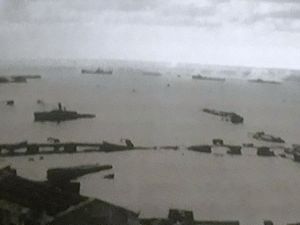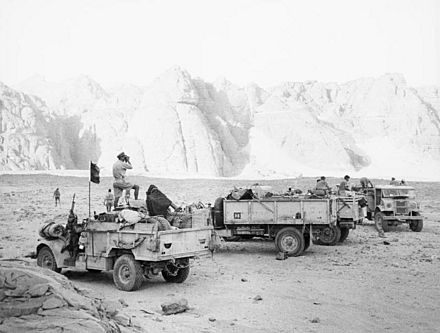Operation Agreement facts for kids
Quick facts for kids Operation Agreement |
|||||||
|---|---|---|---|---|---|---|---|
| Part of the Western Desert Campaign and the Battle of the Mediterranean of the Second World War | |||||||
 The Italian torpedo boats Castore and Montanari (top right) firing upon British MTBs and MLs at Tobruk harbour, 14 September 1942 |
|||||||
|
|||||||
| Belligerents | |||||||
|
|
|||||||
| Commanders and leaders | |||||||
| Strength | |||||||
|
|
||||||
| Casualties and losses | |||||||
|
|
||||||
Operation Agreement was a secret military plan during the Second World War. It took place from September 13 to 14, 1942. British, Rhodesian, and New Zealand forces tried to attack Tobruk, a city in Italian Libya. Tobruk was held by the Axis Powers (Germany and Italy).
This operation was a combined land and sea attack. Some special British soldiers, who spoke German, also went behind enemy lines. Other smaller attacks were planned to distract the enemy. These happened in places like Benghazi (called Operation Bigamy), Jalo oasis (Operation Nicety), and Barce (Operation Caravan).
However, the main attack on Tobruk did not go well for the Allies. It was a big failure. The British lost many soldiers, with hundreds killed or captured. They also lost one large warship (a cruiser), two smaller warships (destroyers), six fast attack boats (motor torpedo boats), and many small landing boats.
Contents
Why the Attack Happened: Goals of Operation Agreement
The main goal of Operation Agreement was to weaken the Axis forces in North Africa. The Allies wanted to destroy important military targets. These included airfields, port buildings, supply ships, vehicles, and large oil storage tanks.
The Allies also hoped to capture the Jalo oasis. This desert oasis was planned as a meeting point for the soldiers involved in the other distraction attacks. It would be a safe place for them to gather after their missions.
How the Operation Unfolded: The Main Events
Setting the Stage: Diversionary Attacks Begin
Before the main attack on Tobruk, other smaller operations took place to confuse the enemy.
- Attack on Barce Airfield
A group of 50 men from the Long Range Desert Group (LRDG) attacked the Barce airfield. They used 12 light trucks and five jeeps. They managed to destroy 16 enemy aircraft and damage seven more. During an attack on nearby barracks, the LRDG lost four men and two vehicles. Later, Italian forces attacked the LRDG, damaging or destroying most of their trucks. Seven New Zealanders and three Rhodesians were captured, all of whom were injured.
- Attempted Raid on Benghazi
Another group, led by Lieutenant Colonel David Stirling of the Special Air Service, tried to raid Benghazi. They were supported by other LRDG patrols. However, they were late and were discovered by enemy forces at a roadblock. Since they had lost the element of surprise, Stirling ordered his men to retreat.
- Attack on Jalo Oasis
The Sudan Defence Force and LRDG patrols attacked the Jalo Oasis. Their first attempt on the night of September 15–16 failed. The defenders were ready and had more soldiers. The attackers pulled back on September 19 when Italian relief forces arrived at the oasis.
The Main Attack on Tobruk: Land and Sea Forces
Operation Agreement involved two main forces: a land force and a sea force. The sea force had about 400 Royal Marines and 180 soldiers from the Argyll and Sutherland Highlanders. It also included engineers and a machine-gun platoon. The land force, called Force B, had about 150 SAS soldiers who came from the desert.
The sea force was divided into two parts:
- Force A was meant to land marines on a peninsula north of Tobruk. It was supported by destroyers.
- Force C was made up of smaller coastal boats. It was directed towards an inlet east of Tobruk harbour.
Force B, the land force, managed to capture an Italian coastal gun battery. But Italian marines quickly took it back. The leader of Force B, Lieutenant Colonel John Edward Haselden, was killed in this fight. Most of the enemy's shore defenses and positions stayed in their control.
Force A's Difficult Landing
A group of commandos from the submarine HMS Taku tried to set up guiding lights on the shore for Force A. But bad sea conditions stopped them. The enemy forces in Tobruk had also been made stronger.
The British destroyers HMS Sikh and Zulu were bringing the sea troops. They landed them on the wrong beach, far from where they were supposed to go. The destroyer Sikh, leading the landing, was hit by Italian shore guns and German anti-tank guns. It was hit while soldiers were still getting off.
The Zulu tried to help the Sikh, but couldn't pull it free. The Sikh eventually sank. About 122 crew members were killed. The survivors were rescued by retreating boats and later captured.
Later that day, on September 14, the cruiser HMS Coventry was returning to Alexandria. It was badly damaged by German "Stuka" dive-bombers from Crete. Sixty-three crew members died. The Coventry had to be sunk by the Zulu. A little later, the Zulu itself was hit by German dive-bombers. While being towed, about 100 nautical miles (185 km) from Alexandria, the Zulu sank. Thirty-nine crew members were lost.
Force C's Failed Harbor Entry
Another landing attempt by smaller boats, carrying soldiers from the Argyll and Sutherland Highlanders and a machine-gun platoon, also faced problems. Their machine guns were meant to protect the landing area. Because of very heavy gunfire from Tobruk harbour, only two boats, MTB 261 and MTB 314, made it into the target cove.
MTB 314 got stuck in the shallow water. But MTB 261 managed to land Sergeant 'Dusty' Miller and his group of soldiers before sailing out. Other boats were stopped by harbor defenses and Italian warships. Three MTBs fired torpedoes at enemy ships in the harbor, but they missed.
ML 353 caught fire and was sunk, possibly hit by Italian warships or planes. ML 352, MTB 308, MTB 310, and MTB 312 were also lost to enemy aircraft. MTB 314, the boat that got stuck, was captured by a German minesweeper at dawn. It had 117 sailors and soldiers on board. The remaining boats managed to return to Alexandria, even though they were often attacked by enemy planes.
What Happened Next: The Aftermath
Many British sailors and marines were rescued from the sea by Italian torpedo boats and other enemy vessels. A number of small, slow British landing craft, which were trying to escape, were also captured with their crews.
The commander of the Sikh, Captain John Micklethwait, was captured when an Italian boat seized one of the Royal Marines' landing vessels. A small boat carrying survivors from ML 352 was also caught by an Italian torpedo boat.
The losses for the Allies were very high. About 300 Royal Marines, 160 soldiers, and 280 sailors were lost. The anti-aircraft cruiser Coventry and the destroyers Sikh and Zulu were sunk. Two motor launches, four motor torpedo boats, and several small landing craft were also destroyed. The Royal Marines had 81 killed, and the Navy lost another 217 men when their ships sank. About 576 survivors were taken prisoner.
The Axis forces had much fewer losses. Only 15 Italians and one German were killed. Forty-three Italians and seven Germans were wounded.
See also
- List of British military equipment of World War II
- List of German military equipment of World War II
- List of Italian Army equipment in World War II
- North African campaign timeline
- Battle of the Mediterranean
- List of World War II battles
- British Commandos
Images for kids



